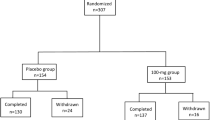Abstract
The use of a dopamine agonist with a long duration of action has theoretical advantages in attempting to reduce the motor fluctuations in Parkinson's disease. We report the results of a double-blind controlled study of adding cabergoline, an ergot derivative with potent long-lasting high affinity for the D2 receptor, to levodopa therapy in 37 patients with severe fluctuations in response to treatment. Increasing dosages of cabergoline (19 patients) or placebo (18 patients) were added to each patient's stable levodopa regime. The two patient groups were similar at baseline in terms of age, disease duration, duration of levodopa treatment, and average hours “off” per day. Following incremental dose titration, patients in the cabergoline group had a significant reduction in hours “off” per day from 5.0 (SD 2.1) to 3.0 (SD 2.5), but there was no change in this measure in the placebo group [4.0 (2.2) and 3.3 (2.3) respectively]. This was not at the expense of a significant increase in dyskinesia. However, there was no difference between the groups when comparing their average Hoehn and Yahr stage of disease, and Schwab and England activities of daily living index.
Similar content being viewed by others
References
Hutton IT, Morris JL, Brewer MA (1993) Controlled study of the antiparkinsonian activity and tolerability of cabergoline. Neurology 43: 613–616
Jori MC, Franceschi M, Giusti MC, Canal N, Piolti R, Frattola L, Bassi S, Calloni E, Mamoli A, Camerlingo M (1990) Clinical experience with cabergoline, a new ergoline derivative, in the treatment of Parkinson's disease. In: Striefler MB, Korczyn AD, Melamed E, Youdim MBH (eds) Advances in neurology, vol 53. Parkinson's disease: anatomy, pathology, and therapy. Raven Press, New York, pp 539–543
Lera G, Vaamonde J, Muruzabal J, Obeso JA (1990) Cabergoline: a longacting dopamine agonist in Parkinson's disease. Ann Neurol 28: 593–594
Lieberman A, Imke S, Muenter M, Wheeler K, Ashklog JE, Matsumoto JY, Maraganore DM, Wright KF, Schoenfelder J (1993) Multicenter study of cabergoline, a long-acting dopamine receptor agonist, in Parkinson's disease patients with fluctuating responses,to levodopa/carbidopa. Neurology 43: 1981–1984
Mouradian MM, Heuser IJE, Baronti F, Chase TN (1990) Modification of central dopaminergic mechanisms by continuous levodopa therapy for advanced Parkinson's disease. Ann Neurol 27: 18–23
Quinn N, Parkes D, Marsden CD (1984) Control of on/off phenomenon by continuous intravenous infusion of levodopa. Neurology 34: 1131–1136
Rolland R, Piscitelli G, Ferrari C, Petroccione A (1991) Single dose cabergoline versus bromocriptine in inhibition of puerperal lactation: randomised, double blind multicentre study. BMJ 302: 1367–1371
Sage JI, Trooskin S, Sonsalla PK, Heikkila RE, Duvoisin RC (1988) Longterm duodenal infusion of levodopa for motor fluctuations in parkinsonism. Ann Neurol 24: 87–89
Author information
Authors and Affiliations
Rights and permissions
About this article
Cite this article
Steiger, M.J., El-Debas, T., Anderson, T. et al. Double-blind study of the activity and tolerability of cabergoline versus placebo in parkinsonians with motor fluctuations. J Neurol 243, 68–72 (1996). https://doi.org/10.1007/BF00878534
Received:
Revised:
Accepted:
Issue Date:
DOI: https://doi.org/10.1007/BF00878534




